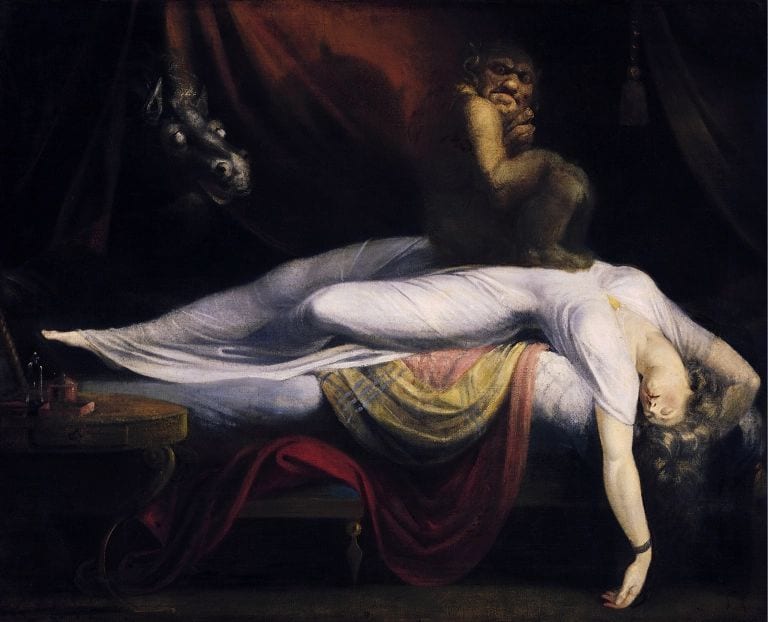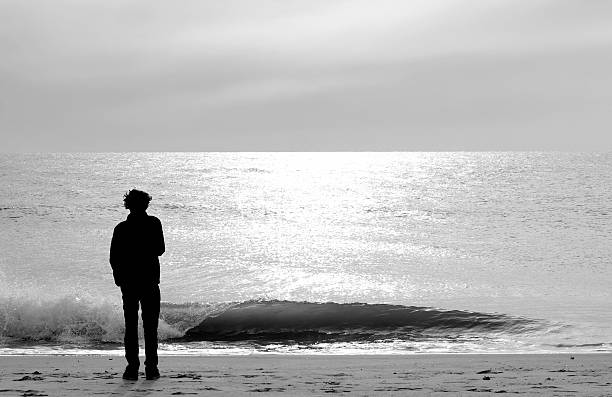It is a moment that feels like an eternity. You open your eyes, and the room looks familiar, exactly as it should. Yet something is wrong—terribly wrong. You try to move, but your body lies frozen, heavy as stone. You try to scream, but no sound escapes your throat. In the corner of the room, shadows seem to gather, and you feel the weight of an unseen presence pressing down on your chest. Your heart races, your mind swirls, and terror grips you with icy hands. Then, as suddenly as it began, it ends. You can move again, breathe again, and the shadows vanish. What just happened?
This chilling experience is called sleep paralysis, a phenomenon that blurs the boundary between dream and reality, waking and sleeping, science and myth. For centuries, people across cultures have tried to explain it through folklore, religion, and superstition. Today, psychology and neuroscience offer clearer answers, though the mystery still feels deeply personal and haunting.
To understand sleep paralysis is to explore not only the mechanics of the brain and body but also the profound ways in which our minds weave reality, fear, and imagination together. It is a story of biology, psychology, and culture—and at its core, a story about what it means to exist in the fragile space between waking life and dreams.
The Science of Sleep: A Dance of Mind and Body
To grasp why sleep paralysis occurs, we must first understand what sleep truly is. Far from being a passive state of rest, sleep is an intricate, dynamic process. It unfolds in cycles, moving between light sleep, deep sleep, and the vivid dreamscapes of REM sleep (rapid eye movement).
During REM sleep, the brain becomes highly active, almost as active as when awake. This is the stage where most dreams occur—fantastical, emotional, and sometimes terrifying narratives spun by the unconscious. Yet while the mind dances through dreamscapes, the body is intentionally paralyzed by the brainstem. This condition, called REM atonia, prevents us from physically acting out our dreams. Without it, we would thrash, run, or even injure ourselves in response to dream activity.
In sleep paralysis, something unusual happens. The brain begins to wake up, returning to a state of awareness, but the body remains locked in REM atonia. The result is a terrifying mismatch: you are conscious but unable to move. The dream world has not entirely let go of you, and fragments of REM imagery can bleed into waking perception, creating hallucinations that feel as real as anything in the physical world.
The Terrifying Experience of Sleep Paralysis
To the person caught in sleep paralysis, the experience is more than biological—it is visceral, emotional, and deeply terrifying. People often report a crushing weight on their chest, as though something or someone is sitting on them. Breathing may feel restricted, even though the body continues to function normally. The mind interprets these sensations through fear, often conjuring shadowy figures, intruders, or supernatural entities.
Some describe a presence in the room, watching them with malicious intent. Others feel as though they are floating outside their body, teetering between dream and reality. The sense of dread is so overwhelming that many believe they are on the brink of death.
These hallucinations are not random—they are shaped by cultural expectations, personal fears, and the psychology of survival. The mind, trapped in a state of alarm, tries to make sense of its immobility and the eerie sensations coursing through the body. The result is an experience that feels both deeply real and utterly unreal, a nightmare that refuses to stay confined to sleep.
The Cultural Faces of Sleep Paralysis
Throughout history, cultures around the world have crafted stories to explain the strange terror of sleep paralysis. In medieval Europe, it was attributed to witches or demons. The infamous “incubus” or “succubus” was said to sit on the chest of the victim, draining life or energy. Artists captured these haunting visions in paintings like The Nightmare by Henry Fuseli, where a demon crouches on a sleeping woman as a shadowy horse peers from the darkness.
In Japan, sleep paralysis is called kanashibari, meaning “bound in metal.” Folklore describes spirits pinning sleepers down, a punishment or warning from the unseen world. In parts of Africa, it is often associated with witchcraft, curses, or spiritual attack. In the Caribbean, people speak of being “ridden by the hag,” a malevolent entity that sits on the chest and strangles breath.
Despite cultural differences, the core imagery is strikingly similar: immobility, a crushing weight, and an ominous presence. This universality suggests something deeper—that sleep paralysis taps into fundamental aspects of the human psyche, especially our instinctual fear of being trapped, suffocated, or hunted in the dark.
The Neuroscience of a Nightmare
Modern science has worked to unravel the mechanics behind sleep paralysis. At its core, it is the product of disrupted transitions between sleep and wakefulness. Normally, REM atonia fades as the brain shifts into wakefulness. But in sleep paralysis, the timing is off—the body remains paralyzed while the mind regains awareness.
Brain imaging studies suggest that during sleep paralysis, the amygdala, the brain’s fear center, is hyperactive. This amplifies feelings of dread, making the experience emotionally intense. At the same time, the brain struggles to distinguish between dream imagery and waking perception, leading to vivid hallucinations.
Neurotransmitters such as GABA and glycine, which regulate muscle paralysis during REM sleep, are likely involved in prolonging the immobility. Meanwhile, irregularities in the sleep cycle—often caused by stress, sleep deprivation, or disrupted schedules—make episodes more likely.
Thus, sleep paralysis is not a supernatural visitation but a neurological misfire. Yet knowing this does not always lessen the fear. For the sufferer, the terror is no less real simply because science can explain it.
The Psychology of Fear in Sleep Paralysis
Why is sleep paralysis so frightening? Part of the answer lies in evolutionary psychology. Humans are wired to detect threats in the dark. Our ancestors, vulnerable to predators at night, developed a hypersensitivity to signs of danger. The rustle of leaves, the shadow of movement, or the feeling of being watched could mean life or death.
Sleep paralysis hijacks this ancient survival system. The immobility of the body triggers panic, the sense of suffocation mirrors primal fears of strangulation, and the hallucinated intruders embody the predators our ancestors dreaded. In this sense, sleep paralysis is not just a glitch in the brain—it is a collision between biology and deep-rooted evolutionary fears.
Sleep Paralysis and Mental Health
Though anyone can experience sleep paralysis, it is more common in people with certain psychological conditions. Anxiety, post-traumatic stress disorder, and depression all increase the likelihood of episodes. Irregular sleep patterns, often linked to stress or shift work, also play a major role.
Sleep paralysis can itself become a source of anxiety. Those who experience it frequently may dread going to sleep, leading to insomnia and heightened stress, which in turn increases the risk of more episodes. This vicious cycle highlights the close relationship between mind, body, and sleep.
Interestingly, some researchers suggest that people with creative or imaginative minds may be more prone to sleep paralysis, as their brains are more adept at weaving vivid dream imagery into waking experience. What terrifies some may, in others, inspire art, stories, or even spiritual exploration.
The Fine Line Between Science and Spirituality
While science explains the biology of sleep paralysis, the personal and cultural interpretations cannot be dismissed. For many, the experience is not merely neurological—it feels spiritual, mystical, or otherworldly. Some describe encounters with ancestors, spirits, or divine beings during paralysis. Others view the phenomenon as a doorway to out-of-body experiences or lucid dreaming.
Psychology recognizes that the meaning people give to their experiences matters deeply. Whether one interprets sleep paralysis as a demon attack, a brain glitch, or a spiritual visitation, the emotional impact is real. To dismiss cultural or personal interpretations outright is to overlook the richness of human belief and imagination.
Finding Ways to Cope
For those haunted by recurring episodes, coping strategies are essential. Maintaining regular sleep schedules, reducing stress, and practicing relaxation techniques can help. Some people find comfort in reminding themselves, during paralysis, that the experience is temporary and harmless. Others train themselves in lucid dreaming techniques, turning terror into exploration by consciously shaping the dreamlike state.
Therapists sometimes work with sufferers to reframe the experience, reducing fear by understanding its mechanics. For many, simply knowing that sleep paralysis is a recognized, natural phenomenon—rather than a supernatural attack—can ease the burden of fear.
The Strange Gift of Sleep Paralysis
Though terrifying, sleep paralysis also offers a rare glimpse into the mysterious workings of the human mind. It reveals how fragile the boundary between waking and dreaming truly is, how easily reality can blur, and how powerfully our brains shape perception.
For some, it becomes not just a source of fear but of fascination. Writers, artists, and thinkers have drawn inspiration from their episodes, turning nightmares into creativity. Sleep paralysis reminds us that the mind is both fragile and astonishing, capable of conjuring entire realities that feel indistinguishable from the physical world.
Conclusion: Between Shadow and Light
Sleep paralysis is more than a clinical phenomenon—it is a profoundly human experience. It terrifies, mystifies, and fascinates. It bridges biology and psychology, science and myth, fear and imagination. In its grip, we confront some of our deepest vulnerabilities: the loss of control, the fear of death, the sense of being hunted in the night.
And yet, sleep paralysis also reminds us of our resilience. Every episode ends. Every paralysis fades. The body awakens, the shadows dissolve, and the world returns. What lingers is the memory—a reminder of how extraordinary the mind is, how thin the veil between dream and reality can be, and how much remains to be understood about the mysterious landscape of sleep.
In the end, the psychology of sleep paralysis is a story of thresholds: between night and day, body and mind, fear and understanding. It is a reminder that even in our most vulnerable moments, the mind is capable of extraordinary feats—turning shadows into monsters, silence into screams, and sleep into one of the most haunting experiences known to humanity.






